Fr. Áureo da Costa Nunes e Castro was born on the 18th of January 1917, on the island of Pico, Azores. When he was fourteen left for the Orient and in Macao was admitted to the Seminário de S. José (St. Joseph's Seminary), where he was ordained twelve years later and there celebrating his first mass.
He was to become the priest of the parish of S. Lourenço (St. Lawrence), fulfilling with great dedication his ecclesiastic duties. This must have been a crucial period of his life, as during these years he wrote several works for the church's choir, to be performed at liturgical celebrations.
In 1952 he was enroled to study composition in the Conservatório Nacional de Lisboa (National Conservatory of Lisbon), having obtained his degree with honours in 1958. He returned to Macao this same year, becoming a music teacher at the Seminário de S. José. A competent pedagoge, he developed among his students the appreciation for Gregorian music, developing their skills not only in understanding but also in performing the rich intricacy of early ecclesiastical poliphony.
In 1959 he founded the Grupo Coral Polifónico de Macau (The Macao Choral Polyphonic Ensemble) which, during three decades, delighted the Macanese with a high calibre repertoire of excellent quality musical harmony and literacy, seldom before performed at local concerts. Besides including sacred and secular Renaissance polyphony, this repertoire promoted a true interchange and interpenetration of cultures consisting of Chinese songs (sung by Portuguese without knowledge of that language) Portuguese tunes (interpreted by Chinese without knowledge of the Portuguese language). His fame as choir conductor having reached Hong Kong, he was invited to direct one of the most prestigious choir groups in the neighbouring colony, a function which he held for more than one year. The vast and diversified choral range of the Grupo Coral Polifónico de Macau testified a concern to include works by classical and Renaissance European masters, particularly those by Portuguese polyphonic authors such as: Pedro de Cristo, Francisco Martins, Manuel Cardoso, Diogo Dias Melgaz, Joaquim Casimiro, Filipe de Magalhães, the king Dom João IV, and others.
In 1962, faced by a rising number of disciples insistently requesting him music and, especially, piano classes, he decided to found the Academia de Música S. Pio X (St. Pius X Academy of Music) which remains to the present one of the most important music tuition centres in Macao. The foundation of the Academia brought to Macao the implementation of systematic and efficient piano courses. The results were promising.
With the passing of time a pleiad of graduated talented musicians came to give honour and prestige to the Academy. Some stayed in Macao but most settled in Hong Kong. Others made their careers abroad, worldwide from Australia to Canada and the United States of America, to Switzerland and, obviously, Portugal.
To mention Áureo de Castro as a musician is to mention one of the most important figures of the twentieth century music in Macao — a person to whom the culture of the territory is greatly indebted. As a human being he was a friend of the best, having with all a generous and straightforward behaviour. As a priest he was a humble and devout servant of Christ and the Church. During the last years of his life, experiencing great difficulty in moving and incapable of fufilling his cannonical duties in church, he requested a special license from the Bishop of Macao to celebrate mass in his room.
During his life he attracted to Macao many foreign musicians, soloists and choirs specialists of a wide range of musicalities. If these encounters provided him with valuable musical insights, in most cases the visitors expressed being strongly impressed by Aureo Castro's gifted personality. His meeting with a Chinese composer then working on Chinese songs (structured in a pentatonic scale) strongly flavoured by Occidental harmonics (based in a heptatonic scale) was crucial for the reorientation of the author's work towards purer melodics more within the spirit of the traditional sources and less artificially crafted with forced alien imported elements.
His lifetime contact with Chinese people and culture is strongly apparent in his musical production. The pentatonic scale of Chinese music is essentially modal. And so is Gregorian music, of which Áureo Castro's was so fond and which he always implemented in relation to his ecclesiastic vocation. This explains the reason why his most important works basically have a modal structure. Such is the case with the composer's TE DEUM, CANTICA PSALMONICA, SUITECHINA ("Cenas de Macau ") (CHINA SUITE ("Macao Scenes"), RITMOS CHINESES (CHINESE RHYTHMS) and the Chinese songs harmonised for choir [see: below, 5.].
Áureo Castro had a particular 'language' of fecund originality and solid intellect. His works are 'solidly built', well 'architectured', rich in musical texture, charismatic in style, and of a great personal brio. As with any other outstanding creative artist, so he found it important to fully admit the autenticity of his pieces. This principle led him to become obsessed by perfectionism. He took to the habit of repeatedly correcting what he had previously considered finished. Such exhaustion makes it virtually impossible to modify, add or even improvise on his definitive scores.
In the Lisbon daily "Diário de Notícias" of the 27th of December 1974, Gil de Miranda, writing on the occasion of the death of his tutor Jorge Croner de Vasconcelos — a great composer and one of the most outstanding Portuguese pedagogues of this century , declared: "Jorge Croner de Vasconcelos is an example of what so frequently happens with genial entities: that, because of the discretion and silence in which they conduct their lives, they are seldom known by the general public. Or at least, they end up being less respected than others who worked more diligently in their own promotion or who were simply more bombastic or pugnacious." These lines have much truth in them! Frequently, true and great men are those who live ignored and undiscovered, as fabulous hidden treasures.
Gil de Miranda's unlimited admiration for his tutor is not surprising. Jorge Croner de Vasconcelos was the fundamental pedagogue to the musical education of a large number of the best Portuguese musicians of the second half of this century: Álvaro Cassuto, Álvaro Salazar, António Vitorino de Almeida, Armando Santiago, Constança Capedeville, Filipe Pires, Filipe de Sousa, Jorge Peixinho, Gil Miranda, Maria de Lurdes Martins, and many others.
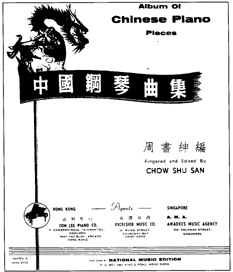 Frontespiece.
This Album of Chinese Piano Pieces, includes the "Ritmos Chineses" ("Chinese Rithms") by Fr. Áureo Castro.
Frontespiece.
This Album of Chinese Piano Pieces, includes the "Ritmos Chineses" ("Chinese Rithms") by Fr. Áureo Castro.
Bearing in mind the extremely time consuming tasks of orientating and directing both the Grupo Coral Polifónico de Macau and the Academia de Música S. Pio X, and considering that he was not a prolific composer by virtue of his character, it can be said that Aureo Castro's musical legacy was an ample and diversified body of works.
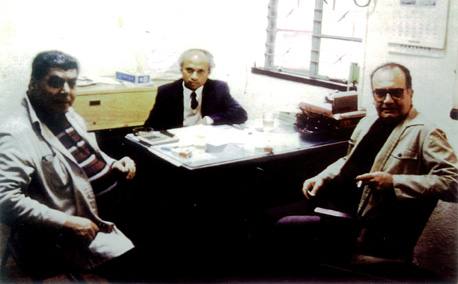 Left to right: Fr. Áureo Castro, Simão Barreto and Filipe de Sousa.
The Organizing Committee for the Comemorações do XXV Aniversário da Academia de Música S. Pio X (25th Anniversary Commemorations of the St. Pius X Academy of Music).
Photograph taken in January 1987.
Left to right: Fr. Áureo Castro, Simão Barreto and Filipe de Sousa.
The Organizing Committee for the Comemorações do XXV Aniversário da Academia de Música S. Pio X (25th Anniversary Commemorations of the St. Pius X Academy of Music).
Photograph taken in January 1987.
The Instituto Cultural de Macau (Macao Cultural Institute) has recently created a research team in charge of compiling, cataloguing, analysing and studying the complete musical works of Áureo Castro, aiming at a future publication of a catalogue raisonné of his scores. This research team is constituted of Luís Maia, director of the Conservatório de Macau (Macao Conservatory), Énio de Souza, and myself.
With the implementation of this project, Áureo Castro's works have been classified under the following categories:
1. Orchestra and/or Chamber music,
2. Piano and/or organ,
3. Piano an/or organ and voices,
4. Orchestra and choir,
5. A cappella choir, and
6. Choir with instrumental accompaniment.
1. ORCHESTRA AND/OR CHAMBER MUSIC
1.1. TOCATA E MINUETE (TOCATA AND MINUET) — in d minor, by Carlos Seixas. Transcription for string quartet.
1.2. SCHERZO — of the Sonata no. 12 Opus26 in A flat major by Ludwig van Beethoven. Orchestration for symphonic orchestra.
In fact, the composer never created an original orchestral work. Besides a few isolated piano pieces, his vocation was foremost centred in ecclesiastic choir works with or without instrumental accompaniement.
2. PIANO AND/OR ORGAN
2.1. FUGA EMLÁ BEMOL (FUGUE IN A FLAT MAJOR) — in three sections. For piano or organ.
2.2. SUITE CHINA ("Cenas de Macau") (CHINA SUITE ("Macao Scenes")) —with three movements. For piano.
There exist a number of orchestral notations by Áureo Castro for the second movement, called "Oração num Templo Budista" ("Prayer at a Buddhist Temple"). Regarding this work, the author contributed with some statements for the programme of one of its performances given by the pianist Margaret Lynn, in 1976: "These scenes, written when the author was still a student at the National Conservatory, stand for the first first attempts in the search for an harmonic language relinquishing the classical formalities of tonal harmony. Experiments which would also be adequate to the Chinese folklore melodics, many of which are based in five toned diatonic scales. These original compositions were written with the sole purpose of painting a number of Macanese scenes with colours breathing the Chinese atmospheres of those scenes."
The First movement is "pôr-do-sol na Barra " ("sunset at Barra"), with the return of the fishing boats... An evocation, almost. The Second movment was suggested by a "Prayer at a Buddhist Temple" with the chanting of the bonzes accompanied by occasional chiming of small bells ang gongs...
The Third movement, called "Barcos-dragões " ("Dragon-boats"), is a reminiscence of the 'Dragon' boat race which took place from Ilha Verde (Green island) to Barra in commemoration of the third reelection of the Governor Tamagnini Barbosa. Written 'as a sonata', the suite starts with melodic rhythms and themes suggested by the quitetness of the [waters of the] river and the race's competitivity.
2.3. FUGA CORAL EM MI MAIOR (CHORAL FUGUE IN E MAJOR)— For organ.
2.4. TRÊS CORAIS SOBRE MELODIAS GRE-GORIANAS (THREE CHORALS ON GREGORIAN MELODIAS)—For piano.
2.5. SONATA N°1 (SONATA No. 1)— allegro. For piano.
2.6. SONATA N°2 (SONATA No. 2)— allegro with one movement. For piano.
2.7. SONATINA—with three movements. For piano.
2.8. RITMOS CHINESES ("Danças de Siu Mui Mui") (CHINESE RHYTHMS ("Siu Mui Mui Dances"))—For piano. Printed in Hong Kong, in 1969.
These same dances were later included in the Album of Chinese Piano Pieces edited by Chow Shu Chan, in Hong Kong, also in 1969.
Chow Shu Chan, a renowned composer and pianist educated at the Paris Conservatoire with Alfred Cortot and Benvenutti, was a former teacher of the Beijing Music Conservatory and the Guangzhou Arts Academy.
In 1985, a variation for string orchestra of this piece, by Simão Barreto, was performed at the Aula Magna of the University of Lisbon (Lisbon).
2.9. RITMOS CHINESES ("Nostalgia ") (CHINESE RHYTHMS ("Nostagia"))—For piano. Printed in Hong Kong, in 1970.
3. PIANO AND/OR ORGAN AND VOICES
3.1. HINO (HYMN)—with words by Osório Goulart. For voices and piano.
3.2. LEMBRA-TE, PAPÁ (DADDY, DO YOU REMEMBER)—with words by St. Thereza of Lisieux. For voices and piano.
3.3. A RECALLING MOONLIGHT—For voices and piano.
3.4. HOSSANA—motet. For voices and organ.
3.5. ORAÇÃO DA NOITE (NIGHT PRAYER)—song. For voices and piano.
3.6. LEMBRAI-VOS (REMEMBER)—song. For voices and piano.
3.7. DÁ SHÊ TCHIN MEI [TA XUE XUN MEI]• (STEPPING ON THE SNOW) — Chinese song. For voices and piano.
3.8. CARANDÁ MA [N]DU (BEAUTIFUL CARNAUBA) — Brazilian (?) folksong. For voices and piano.
3.9. MENINA DE OLHOS VERDES (GREEN EYED LITTLE GIRL)—words by Luís de Camões.For voices and piano.
3.10. ORAÇÃO DA NOITE (NIGHT PRAYER)—religious song. For voices and organ.
3.11. DUAS MELODIAS RELIGIOSAS PARA USO LITÚRGICO (TWO RELIGIOUS MELODIES FOR LITURGY)—For voices and piano.
4. ORCHESTRA AND CHOIR
4.1. TE DEUM LAUDAMUS—For choir and orchestra.
There is a variation for four mixed voices and organ. The orchestral arrangement of the last section was completed by Simão Barreto.
4.2. ADESTE FIDELIS —For a four-voices' choir and symphonic orchestra.
4.3. HODIE CHRISTUS NATUS EST—a Christmas song by Feltz. A variant for four mixed voices and chamber orchestra.
4.4. SANTA CECILIA (SAINT CECILY)—short cantata. For choir with solo and chamber orchestra.
The final choral fugue was not finished.
5. A CAPPELLA CHOIR
5.1. MÚSICA DE CENA PARA O "AUTO DA ALMA" DE GIL VICENTE (SCENOGRAPHIC MUSIC FOR THE "AUTO OF THE SOUL" BY GIL VICENTE) — For three 'equal' voices.
5.2. O MENINO ESTÁ DORMINDO (THE CHILD IS SLEEPING) — double circular canon. For six voices.
5.3. AY, SANTA MARIA (HEY, HOLY MARY)— vilancico [a specific form of Portuguese madrigal] by an anonymous author. A variant for three 'equal' voices.
5.4. STELLA DE DIA (DAY STAR)—a song of Alfonso the Wise. Variant for four 'equal' voices.
5.5. JESUS A DORMIR (JESUS AT SLEEP)—motet. For four children's voices.
5.6. MILHO VERDE (GREEN CORN)—popular song. Variant for three male voices.
5.7. HODIE SCIETIS—motet. For three children's voices.
5.8. A BELÉM, PASTORES (SHEPERDS, TO BETHELHEM)— traditional Portuguese Christmas song. For four mixed voices.
5.9. CHRISTMAS HAS BEGUN — traditional Christmas song. For four mixed voices.
5.10. SENIORES POPULI—Holy Week responsory. Variant for four mixed voices.
5.11. SENIORES POPULI—original version responsory. For three male voices.
5.12. PUER NATUS - ALLELUIA—traditional English Christmas song. For four male voices.
5.13. O SENHOR É MEU AMPARO (THE LORD IS MY HELP) — invocation. For four mixed voices.
5.14. COR JESU—invocation. For three 'equal' voices.
5.15. PIE JESU—invocation. For three 'equal' voices.
5.16. A VÓS SENHOR (TO YOU OH LORD) — tune by Fr. Alfredo (?). For four mixed voices.
5.17. NEVE, NEVE SEM CESSAR (SNOW, INCESSANT SNOW) —popular Russian song. For four mixed voices.
5.18. O QUAM SUA VIS—motet. For three mixed voices.
5.19. ET INCARNATUS—motet. For three mixed voices.
There is a variation of this piece.
5.20. HUNG TAU TSI [HONDOU CI]• [DÁ SHÊ TCHIN MEI] (LOVE POEMS)— variation of the popular Chinese song. For four mixed voices and soprano.
There is a variation by Simão Barreto for clarinet, guzheng (Chinese harp), and a string quartet. In 1994, this variation was performed by Simão Barreto, at the Casa Garden, in Macao.
5.21. HU PIEN SHAO NU• [HUBIAN SHAONÜ] — variation of the popular Chinese song. For four mixed voices.
5.22. CHIAN KUN YUN, MIAO FA [QIANKUN YU MIAOFA]• (THE MYSTERIOUS WAYS OF THE UNIVERSE) — variation of the"Psalm No. 19" by Chiang Wen Yeh. For four mixed voices.
5.23. GONG TSI FA CHOI [GONGXI FA CAI]• (GREETINGS AND PROSPERITY) — variation of the popular Chinese New Year's song. For four mixed voices.
5.24. O COR AMORIS—motet. For three 'equal' voices.
5.25. CREMOS EM VÓS (WE BELIEVE IN YOU) — motet. For three 'equal' voices.
5.26. INTER VESTIBULUM—motet. For three 'equal' voices.
5.27. DEZOITO MELODIAS RELIGIOSAS PARA USO LITÚRGICO (EIGHTEEN RELI-GIOUS MELODIES FOR LITURGY) — For three of four 'equal' voices.
5.28. ASTRONAUTAS DO AMOR (LOVE ASTRONAUTS) — words by Mgr. Manuel Teixeira. For three male voices.
6. CHOIR WITH INSTRUMENTAL ACCOMPANIEMENT
6.1. TE DEUM LAUDAMUS — For organ and four mixed voices. (See: 4.1).
This variation was composed as the Portuguese première of this master piece, performed in 1958, at the church of S. João de Deus, in Lisbon.
6.2. CANTICA PSALMONICA—divided into two groups:
6.2.1. CANTICUS PSALMONICUS I—twelve salmodic motets, and
6.2.2. CANTICUS PSALMONICUS II— comprising six pieces based on biblical psalms. They both are for organ and two or three 'equal' voices.
6.2.3. CANTICUS PSALMONICUS III — assorted pieces with similar characteristics as I and II, being currently grouped.
This is the composer's capital choir work, and undoubtedly one of the greatest original works of Portuguese religious music.
6.3. CINCO MOTETOS (FIVE MOTETS)—dedicated to the choir group of the church of S. Lourenço, in Macao. For two or three 'equal' voices and organ.
6.4. ALMA MINHA GENTIL (GENTLE SOUL OF MINE) — words by Luís de Camões. For three children's voices and piano.
6.5. TERRA TREMUIT — motet. For four male voices and organ.
6.6. SURREXIT DOMINUS — motet. For three mixed voices and organ.
6.7. SENHOR EU NÃO SOU DIGNO (LORD I AM NOT DESERVING) — motet. For two 'equal' voices and organ.
6.8. PANIS ANGELICUS—motet. For two mixed voices and organ.
6.9. TANTUM ERGO—motet. For two mixed voices and organ.
6.10. YU GUAN CHU• [YUGUANGQU] (THE FISHING LIGHT SONG)— variation of a Chinese barcarole. For four mixed voices and piano.
Translated from the Portuguese by: Rita Camacho
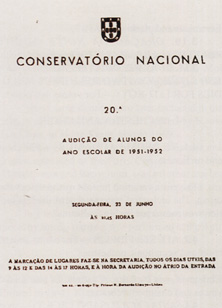
NATIONAL CONSERVATORY
20th / Audition of Students of the / 1951-1952 Academic Year Monday, the 23rd of June / At hours 21.45.
Seats can be booked at the Secretary, any week day, from 9.00 to 12.00 am and from 14.00 to 17.00 pm, and the time of the Audition in the Entrance Hall.
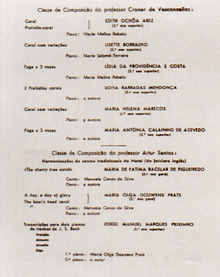
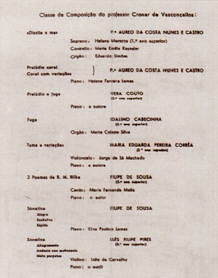
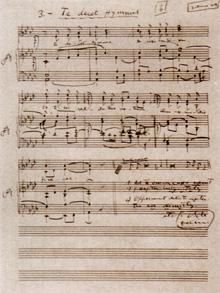
Cantica Psalmodica I, Psalm 64: "Te Decet Hymnus".
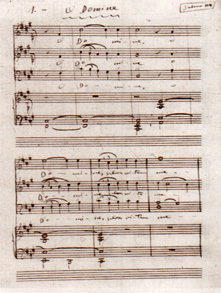
Cantica Psalmodica I, Psalm 114: "O Domine".
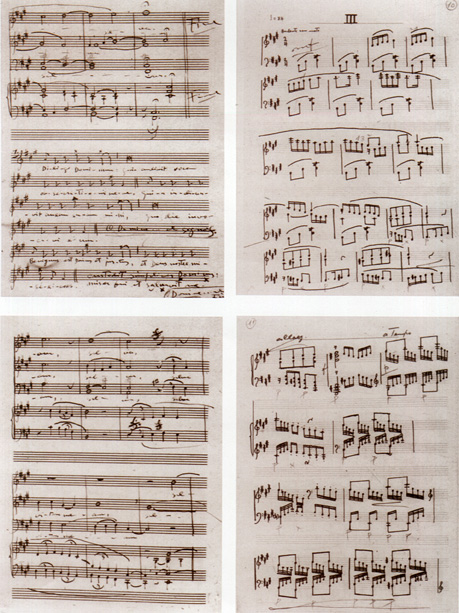
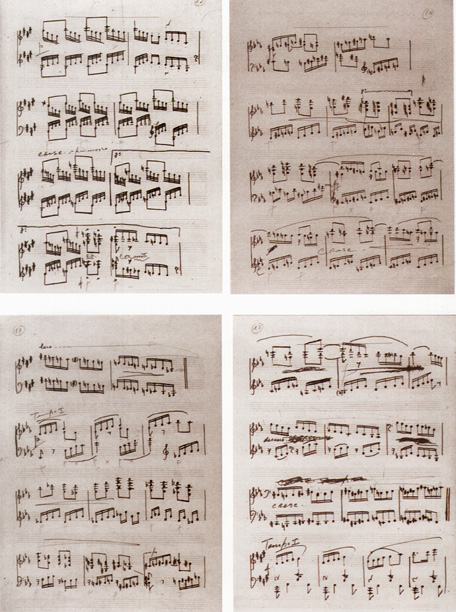
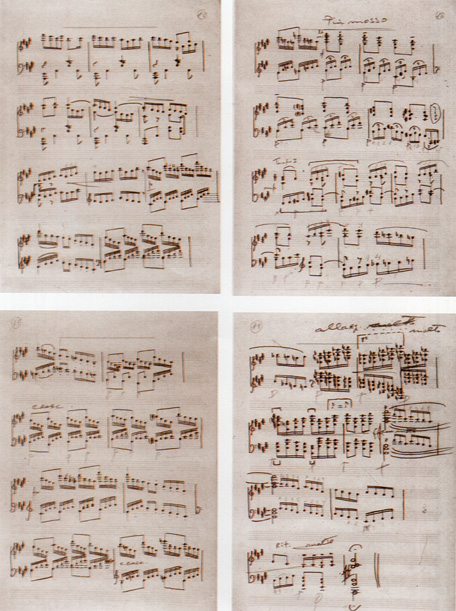
Suite China (China Suite), Third Movement: "Dragon Boats"
start p. 141
end p.